If you search on Amazon for books using the key phrase “UX design”, more than 1,000 titles will appear. That’s a lot of titles to wade through if you’re looking to read about user experience! One of the most difficult parts of making a list of the best UX books is that there are so many awesome ones out there. I could write a must-read list that goes on forever.
I chose the following UX titles either because they have played a significant role in the way I view my place as a UX designer or because they address foundational design topics that every UX designer should understand. I’m leaving out a fair number that have been published in all aspects of design, from usability and research to interaction design and how to present and speak to your design decisions. This reading list is intended for you to use as a starting point.
1. Badass: Making Users Awesome by Kathy Sierra
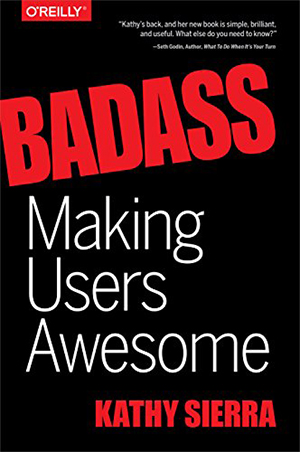
Kathy Sierra’s book is all about the strategy for creating successful products and services. Badass: Making Users Awesome looks at how to look at a product or service from the user’s perspective.
So instead of relying on marketing tactics that might be unethical, we can create products that lead users to champion them with their friends and family. A win for everyone!
The design and layout of the book is unlike that of most — it lays out the argument with a lot of visuals. And it’s an easy read. This has led to some negative reviews complaining that the book is just a PowerPoint PDF. Lay that aside, and the message is strong. It’s a great look at the point-of-view statement and how a well-written one can be influential in creating awesome products that users love.
When you read this book, it will start to make sense why some products do really well in the market and why others don’t. It will help show you how to shift your design strategy so that it can be successful too.
2. Just Enough Research by Erika Hall
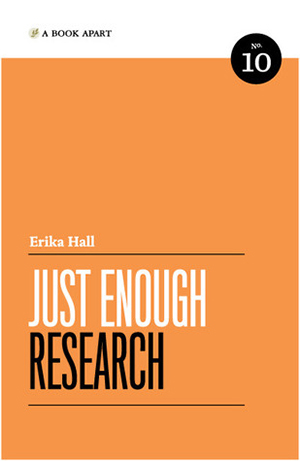
Erika Hall’s book on UX research is a joyful and informative read you could probably finish in a single day.
This slim how-to manual, published by A Book Apart, walks the reader through the basics of user research, from talking to stakeholders in an organization through analysis and reporting. Hall’s writing style makes the topic — which can be dry in other books — fun and approachable.
She’s also realistic in her advice to readers. She recognizes the constraints in time and budget that all UX designers face in their day to day jobs, so she proposes how best to navigate these situations and what alternative methods to employ.
Just Enough Research’s current edition was updated with a new chapter on surveys and why designers must be very careful about using these often-abused metrics in their research.
Even if you aren’t a UX researcher, this book explains how you can implement research in your process and spot your own biases so you can design a better user experience.
3. The Design of Everyday Things by Don Norman

The Design of Everyday Things is a standard on most design-reading lists for a reason. This book was originally published in 1988 with the title “The Psychology of Everyday Things”. It was revised in 2013 with a major update to some of the examples to make it more relevant to today.
Norman’s book lays the landscape for usability in human-centered design. In it, Norman lays out how human psychology affects everyday actions, why it’s natural for humans to make mistakes, and how technology can help rather than cause errors. Norman also explains human-centered design and proposes principles for good design.
I listened to this book on Audible, and a PDF accompanied the audio book so I could view the examples, which are especially helpful in understanding affordances and signifiers.
Vox produced a great video about one of the examples in the book — how doors are designed well, and how they are designed badly. If you’ve ever struggled with figuring out a door, sink, stove, switches, or other interface — the problem isn’t you. It’s the design.
Norman’s classic book explains why bad design happens, what good design is, and the constraints designers face when designing.
4. Designing with the Mind in Mind by Jeff Johnson
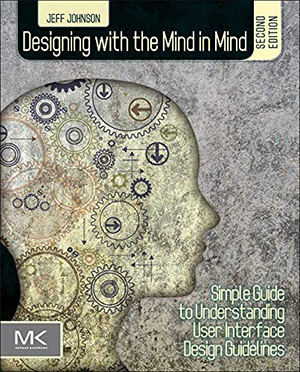
Sometimes designers follow a set of rules for designing user interfaces without understanding why certain patterns and methods work. This book changes that.
Jeff Johnson’s Designing with the Mind in Mind lays out the perceptual and cognitive psychology that are the foundation for intuitive interfaces.
For example, how does human perception work? How is the eye structured and how do we read? What can we do as designers to ensure that people can see the information we design?
Johnson walks through an explanation of human vision, attention, memory, and decision-making for a deep-dive into why we perceive the way we perceive. After reading this book, UX designers will have a better idea of why we have design rules so they can make educated decisions about tradeoffs between budget, time, and competing design rules.
5. About Face: The Essentials of Interaction Design 4th Edition by Alan Cooper, Robert Reiman, David Cronin, and Christopher Noessel
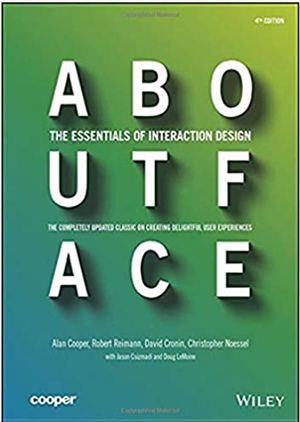
About Face completely changed the way I think about interaction design. Admittedly, I’ve only read sections of the book, due to its length. Still, it’s a reference when I have questions about how to approach interaction design and UI design.
This book is broken into three parts. It starts with introducing goal-directed design and how to approach digital projects. Then it moves through designing for behavior and form. Lastly, it looks at the differences in designing for desktop, mobile, and web applications.
My read of the book focused on designing for behavior, and my biggest “ah-ha” moment came when reading about optimizing for intermediate users. Much of the struggle designers have is in how to manage the different needs between beginners and experts. This chapter explains that we should focus on intermediates. We should guide beginning users to become intermediates as soon as possible, and aim to provide opportunities for advanced users to use our products without holding them back.
This book includes a number of other useful concepts to consider when designing user interfaces. At 659 pages, it might be a little too much to read in one sitting, but it should be in the designer library.
6. Don’t Make Me Think by Steve Krug
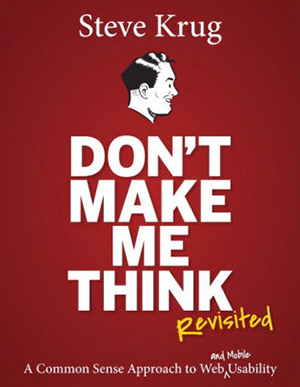
Steve Krug’s classic book introduced me to usability and usability testing, and launched me into my current career as a UX designer. Don’t Make Me Think, Revisited: A Common Sense Approach to Web Usability is now in its third edition.
It’s short, easy to read, and a great manual for designers just getting started in usability testing. Krug wrote it based on his 30 years as a usability consultant for organizations including Apple, NPR, and the International Monetary 足球竞彩网. Even if you already understand why you should do usability testing, chances are you work with people who don’t understand. This book is a great gift for those people. It explains why you should test, how to keep it simple, and how to keep it from being a budget suck. The newest edition has a new chapter about usability for mobile websites and apps, and all of the examples are updated.
If you want to take it a step further, consider Krug’s second book, Rocket Surgery Made Easy: The Do-It-Yourself Guide to Finding and Fixing Usability Problems. This book explains everything you need to know to get started with usability testing with little or no cost. It includes how to recruit, how to conduct a test session, and how to involve your team.
7. Change by Design by Tim Brown
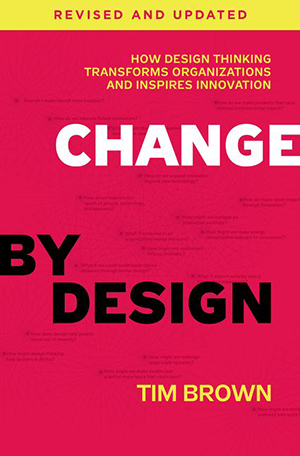
IDEO CEO Tim Brown explains design thinking and how it should be used at every level of a business. This isn’t a manual for designers. It’s geared towards people outside of the industry, but I included it on this list because of the examples.
IDEO is a well-known human-centered design firm, and the examples Brown provides are straight from IDEO’s project list. While sometimes it feels more like a sales pitch, the case studies are interesting examples of how design thinking is applied.
UX designers who read this book can look at design thinking from a perspective outside the industry and use the examples to explain how design thinking can be used in every industry and in every discipline — it’s not just for designers.
Advance your DESIGN career
I couldn’t include all of my favorite user experience books on this list. There are just too many amazing titles, and I already have about three times as many on my “to-read” list. These must-read UX design books are a great place to get started if you’re looking for some summer reading to help you advance your design career.
足球竞彩网 Assembly offers a full time UX design bootcamp course with career coaching support to help you land a job, and free workshops. Kickstart your learning journey today!
